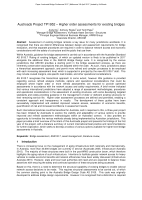Bridges

- Publication no: ABC2017-015-17
- Published: 20 April 2017
- PDF (free) Download
Assessment of existing bridges remains a key issue for many jurisdictions worldwide. It is recognised that there are distinct differences between design and assessment requirements for bridge evaluation, and that separate procedures are required in order to balance network access and economicconsiderations with the safety of a structure and the public that use them.
Within Australia, guidance for bridge assessment is carried out in accordance with the Australian Standard AS 5100.7 Rating of existing bridges, of which an updated version is likely to be published in 2017 alongside the additional titles in the AS5100 Bridge Design suite. It is recognised by the various jurisdictions that AS5100 provides a starting point in the bridge assessment process, as there are inherently conservative assumptions that are adopted within the code. As such, many jurisdictions adopt a hierarchical assessment approach, and permit more refined and complex processes to be employed with each increasing assessment level, which is supported in principal by the new AS 5100.7 draft. Thismay include revised margins, site specific load models, and other operational considerations.
AS 5100.7 recognises this hierarchical approach to some extent, however little guidance is provided regarding various refined analysis methods, options and operational considerations that could be employed where higher order or more refined assessments are required to provide optimised assessments in accordance with the network access and safety requirements. A brief review indicated that various international jurisdictions have adopted a range of assessment methodologies, proceduresand operational considerations in the assessment of existing structures, with some developing targeted standards and codes providing guidance in the management of older or deficient existing structures for their remaining service life. Higher order assessment processes are defined and permitted, enabling aconsistent approach and transparency in results. The development of these guides have been successfully implemented and enabled improved network access, realisation of economic benefits,quantification of risk and increased confidence in assessment results.
Such international practices could be beneficial for Australia, and in response to this, a three-year project has been initiated by Austroads to explore the viability and adaptability of various options to provide improved and refined assessment methodologies within an Australian context. It also provides anopportunity to formalise the various methods already being implemented by Australian jurisdictions. This paper provides a brief overview of the intent of this Austroads project and presents the findings of the first year of the project, with a literature summary of current international best practice and recommendationsfor further exploration, which seeks to develop a toolbox of various options available for higher level bridge assessments in Australia.
